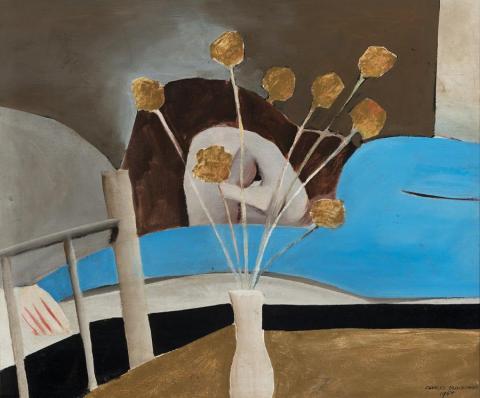THE BLUE DRESS, 1954
CHARLES BLACKMAN
enamel on compressed cardboard
61.5 x 75.0 cm
signed and dated lower right: CHARLES BLACKMAN / 1954
Niagara Galleries Melbourne
Private collection, Sydney
Shapcott, T., The Art of Charles Blackman, Deutsch, London, 1989, pl. 37 (illus.)
The 1950s were a time of intense creativity for Blackman during which he developed his distinctive visual style and motifs, including the Schoolgirl and Alice in Wonderland series. The artist's paintings during this period are characterized by two recurring themes: childhood and blindness. The Blue Dress is a fine, early example of Blackman's oeuvre; an intimate and tender portrait of a reclining young woman depicting imagery that Blackman was to explore throughout his long and eminent career.
Charles Blackman married Barbara Patterson in 1950 and she was to have a profound and lasting effect on his art. Her low vision and eventual blindness allowed Blackman to enter the realm of the imaginary. Furthermore, Blackman's need to describe the world to Barbara heightened his observations and refined his senses. 'Charles Blackman emerged during the 1950s as an artist whose pictures achieved a rare and extraordinary degree of poetic reality.'1
The fusion of the poetic world with everyday reality in Blackman's pictures parallels the relationship that Blackman shared with his wife. 'The rapid evolution of Blackman's pictorial ideas was clearly enriched by Barbara's knowledge of psychology, especially her feeling for Jung.'2 Blackman often read aloud to Barbara. They preferred modern French literature by authors such as Colette, Gide and Alain-Fournier, with an emphasis on novels of adolescent eroticism. The influence of poet Arthur Rimbaud is evident in Blackman's preoccupation with childhood memories and the state of adolescence.
In The Blue Dress, a young girl, dressed in blue, lies on her side with her arm awkwardly outstretched. A vase of flowers sits on the table in front of her, partly obscuring her face. Deep in reflection, her eyes downcast, the girl offers no challenge to the viewer who is left free to contemplate the world of Blackman's creation. Shapcott observes that The Blue Dress 'may initially be seen as a cool exercise in now familiar Blackman patternings: sleeping woman, vase of awkward flowers, corners of furniture; the whole bathed in flat colours whose only surprise is that the petals of the flowers are a withered brown.'3
The Blue Dress is a work that mesmerizes not just because of its striking visual appeal and charming subject matter, but because it hints at something more meaningful below the surface. Blackman's masterful juxtaposition of a vase of flowers against the young girl's face disrupts the picture plane and crates a disquieting effect. We are drawn towards the solitary young girl through the everyday objects that surround her. 'The element of playfulness and the psychological probing of states of innocence and the experience are extremely rare in antipodean art. Blackman has become their master.'4
1. James Mollison,'Director's Foreword', in St John Moore, F., Charles Black: Schoolgirls and Angels, National Gallery of Victoria, Melbourne, 1993
2. Ibid., p. 4
3. Shapcott, T., The Art of Charles Blackman, Deutsch, London, 1989, pp. 14-16
4. bid., p. xi
FELICITY ST JOHN MOORE
